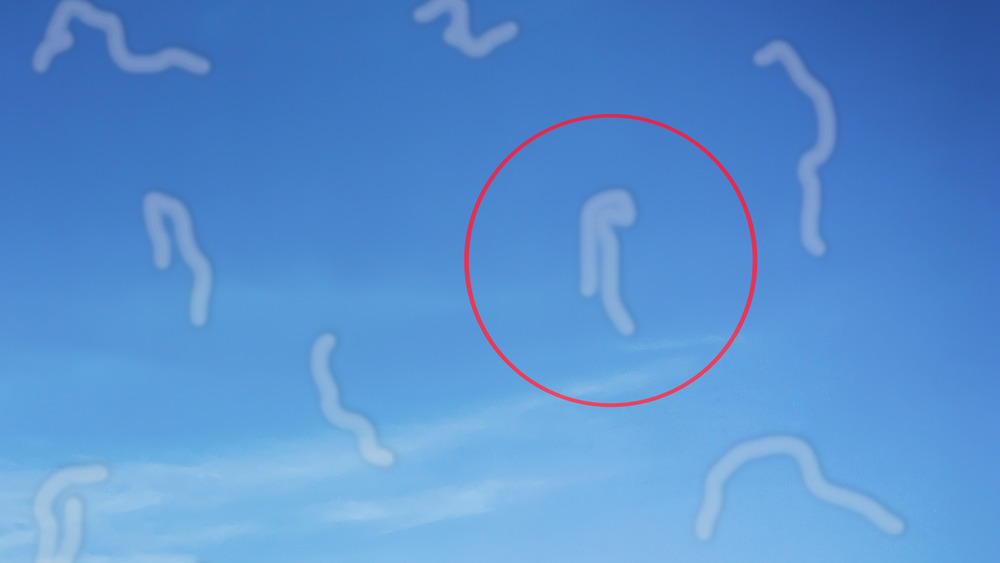What Does It Mean If You Have Eye Floaters?
Imagine this — the warm summer sun is gently caressing your skin, and the sea breeze is kissing your cheeks. With your eyes closed, the sounds of the seagulls overhead and the crashing of the waves take over, and you're simply in paradise. But as you open your eyes and look out across the crystal blue sky, you notice strange dark or transparent shapes floating across the sky in front of you. Does that sound familiar? If so, you're not alone — experiencing eye floaters is much more common than you'd probably think. So what exactly are these annoying little buggers?
The normal anatomy of the eye consists of many different parts, including the vitreous (via National Eye Institute). The vitreous is a gel-like fluid that contains fibers that attach to the retina. Naturally, over time, some of those tiny fibers shrink and can detach from the retina, clumping together and casting shadows against the retina (per National Eye Institute). That leads to what is commonly referred to as floaters — dark or transparent dots, squiggly lines, cobwebs, and other shapes seemingly floating across your visual field. Floaters are commonly observed against bright backgrounds such as a clear blue sky or a crisp white piece of paper.
Risk factors and treatment of eye floaters
While it is common to develop floaters with age, some groups have an increased risk of developing floaters earlier in life. According to the American Academy of Ophthalmology, people who are nearsighted (difficulty seeing far away), have had cataract surgery, or those with diabetes tend to have a higher risk of developing floaters. Less commonly, floaters may be a symptom of more serious eye conditions, including (but not limited to) retinal detachment, eye injuries, and retinal tears.
While floaters tend to be annoying, most people learn to live with them. When the cause of floaters is natural aging, no medical treatment is usually necessary (via WebMD). However, if floaters begin to affect your vision significantly, an eye doctor may recommend a surgery known as a vitrectomy.
There are also instances in which you should seek medical attention immediately. These instances include a sudden increase in floaters, flashes of light, severe eye pain, and any visual loss.
So rest assured the next time you are enjoying a beautiful cloudless sky, there are no strange worms wiggling across the sky — you're simply noticing your floaters.
Eye injuries can lead to the development of floaters
Sustaining an eye injury — whether through physical force, chemical exposure, or a foreign body — can lead to varying degrees of eye damage (via Cleveland Clinic). Eye injuries can range from bruised and swollen black eyes to orbital fractures or retinal detachment. While symptoms are dependent on the type of injury sustained, common ones include but are not limited to eye pain, swelling, redness, blurry vision, decreased visual fields, and the onset of eye floaters.
It is critical to seek medical attention right away when you sustain an eye injury because quick and proper management can prevent long-term complications such as blindness or vision loss. After an initial evaluation, your healthcare provider may need to order additional testing such as X-rays, ultrasounds, or MRIs. Depending on the injury, your healthcare provider will also be able to initiate the best treatment options promptly, decreasing any chance of further or long-lasting damage.
Floaters may be a sign of uveitis
The presence of eye floaters can be annoying but they shouldn't be alarming, as they are a part of normal aging. However, there are circumstances when eye floaters may be indicative of a more serious condition, according to the National Eye Institute. One such condition is known as uveitis. Uveitis is an inflammatory condition of the uvea, the part of the eye in between the sclera and the retina (via National Eye Institute). People with underlying autoimmune conditions like rheumatoid arthritis and ankylosing spondylitis or infections like syphilis and toxoplasmosis are at a higher risk for developing uveitis. Uveitis is most common in people between the ages of 20 and 60 and in smokers.
Symptoms of uveitis include eye pain and redness, sensitivity to light, presence of floaters, and blurry vision. If left untreated, uveitis can potentially lead to vision loss. Thankfully, with proper treatment and management which include topical or oral steroids, most cases of uveitis resolve without any long-term complications.
Floaters could be a sign of retinal detachment
The sudden onset of new floaters could be a symptom of a serious condition known as retinal detachment (per National Eye Institute). The retina refers to a layer of cells located along the back of the eye, which are responsible for detecting light and sending important information and signals to the brain (via American Academy of Ophthalmology). When the retina detaches from its normal position, that is considered a medical emergency and treatment needs to be initiated as soon as possible to prevent blindness.
Symptoms of retinal detachment include a burst of new floaters, visual changes such as a "curtain" coming down in the middle of sides of the visual field, and flashes of light. Retinal detachment can occur after trauma to the eye including after common medical procedures like cataract removal or eye injuries. People with a family history of the condition, diabetic eye changes, and extreme nearsightedness are also at an increased risk of developing retinal detachment. Freeze therapy and surgery are usually the first-line treatments for this condition and if done promptly can save a person's vision.





